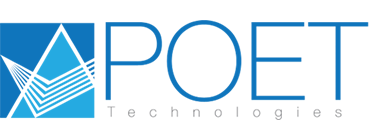POET Technologies Achieves New Milestone and Reports Significant Progress
March 4th, 2014
Toronto, ON, and Storrs, CT, March 4, 2014 – POET Technologies Inc. (TSX-V: PTK, OTCQX: POETF) (“the Company”) – announced today the achievement of continuous-wave (cw) operation of its thyristor laser within its proprietary planar optoelectronic technology (POET) platform for monolithic fabrication of integrated electronic and optical devices on a single semiconductor wafer. The Company is also reporting significant progress on several other initiatives on its technical roadmap.
POET Switching Laser
The Company has achieved the long-awaited milestone (MS-5) – the operation of its switching laser within the POET platform. This achievement has far-reaching implications for on-chip and optical communications applications. This single demonstration is a giant leap forward for an integrated circuit industry looking for ways to push complementary metal-oxide semiconductor (CMOS) processes past some challenging technical barriers.
Peter Copetti, Executive Chairman and interim CEO, noted “This is the most definitive step yet in our drive to enhance POET’s electronic and optical monolithic capability, beyond CMOS and silicon photonics.”
Copetti added, “While timeline variations are always to be expected for a company in development mode, our belief in Geoff Taylor and his team has never wavered. We would like to thank the entire technical team for its hard work and dedication.”
Specifically, excellent switching operation was achieved with a laser threshold of 1-mA, just above a thyristor holding current of 0.5-mA, for a 10-micron diameter laser device, exhibiting a suppression ratio of 50-dB. This enables optical short reach applications found in data-center, server farms and high performance computing, thereby lowering system solution cost when compared to silicon photonics.
Facility Upgrades
In accordance with its planned maintenance scheduled for the POET facility, the Company has completed its most recent wafer growth cycle.
In association with this, POET is upgrading its molecular beam epitaxy (MBE) system to make critical additions and replenish source materials. One critical addition is a high-volume indium (In) source to enable metamorphic growth on a gallium arsenide (GaAs) substrate of the POET epitaxy with a natural wavelength of 1550-nm. This is expected to enable the production of long-wavelength lasers combined with high In-content field-effect transistor (FET) channels for superior high-speed transistor performance.
Drive for Feature Size to 100-nm Range (MS-8)
The Company introduced a milestone associated with reducing feature size to the 100-nm range in scale, and has previously announced that it realized submicron device operation from an initial 800-nm down to 200-nm.
POET is moving steadily towards the goal of 100-nm feature sizes for the transistors within the POET platform, and has stabilized feature definition at the sub-200-nm level. Short channel considerations are being addressed with new innovations, and the critical step of isolating source-drain and gate contacts with oxygen implantation is nearing completion. The 100-nm goal is matched to the state-of-the-art commercial III-V foundry capabilities and will demonstrate greater than 20x speed improvement together with lower power consumption by 4x to 10x, depending on the application, compared to silicon at smaller nodes.
Although timelines are always subject to review depending on partner needs, the technical team sees no significant technical roadblocks ahead. POET anticipates completion of the 100-nm milestone by the end of April 2014.
Technical Development Kits (TDK)
In addition to optimizing device parameters and yields, the Company is focusing on establishing POET’s technology design kits (TDKs). The TDKs comprise a comprehensive design rules and device parameter library for POET, and will enable customers and partners to implement the POET process into preferred foundries. The TDKs will also help licensed designs in a POET device ecosystem to proliferate and help existing silicon library functions to migrate to POET technology-based circuitry in a minimum amount of time.
The Company is reporting that, with the help of select potential POET Development Alliance (PDA) partners, progress on this milestone is ahead of the schedule set by the former Special Strategic Committee. Copetti noted, “It is gratifying to see our excitement shared by others, and we hope that excitement will be infectious as we head into the Global Semiconductor Forum. We have a relentless focus on securing our intellectual property and in forging ties to industry, and this positions POET Technologies in its drive to extend Moore’s Law to the next level.”
By enabling increased speed, density, reliability, power efficiency, and much lower bill-of-materials and assembly costs, POET’s disruptive technology will allow continued advances of semiconductor device performance and capabilities for many years, overcoming the current power and speed bottlenecks of silicon-based circuits, and will change the future development roadmaps of a broad range of semiconductor and other applications including mobile and wearable devices, computer servers, storage arrays, imaging equipment, and networking equipment.
< Back to News
